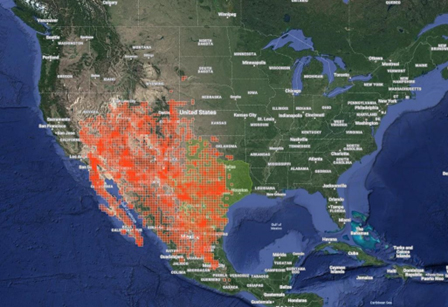Written by: Justin Mair, Colorado Master Gardener Apprentice
One of the staple plant groups of the western American landscape is the cactus and yet our cold winters can often make it difficult for them to survive. Cold-hardy cacti are relatively rare and yet some species have managed to find ways to flourish. The Echinocereus genus, commonly referred to as hedgehog cactus, isa local native that doesn’t just survive, but also has a lot of diversity in Pueblo County. There are five known species in Colorado and four of them grow here in our area. In contrast, Denver only has one species that grows natively, Echinocereus viridiflorus.

Native Range of the Echinocereus Genus, Map Courtesy of iNaturalist.
Echinocereus is a genus containing about 70 species that are typically small cylindrical cacti reaching heights of 12-24 inches tall and grow in mounds. They flower rather spectacularly in May-June and after 6-10 weeks they produce edible fruits. As with most cacti they prefer a well-draining sandy soil, infrequent water, and a whole lot of sun.
Now let’s look at the four species that are Pueblo natives:
- Echinocereus triglochidiatus ssp. triglochidiatus– Kingcup Cactus
Grows to 24 inches tall with red or orange flowers
- Echinocereus viridiflorus ssp. viridiflorus– Green-Flower Hedgehog Cactus
Grows to 12 inches tall with green or yellow flowers
- Echinocereus reichenbachii ssp. perbellus– Lace Hedgehog Cactus
Grows to 12 inches tall with pink or magenta flowers
- Echinocereus coccineus ssp. coccineus– Scarlet Hedgehog Cactus
Grows to 24 inches tall with deep red flowers

Clockwise from top left: Echinocereus triglochidiatus (c) erincall via iNaturalist, Echinocereus viridiflorus (c) amandarl via iNaturalist, Echinocereus reichenbachii (c) adkonings via iNaturalist, Echinocereus coccineus (c) roomthily via iNaturalist. Images licensed under CC-BY-NC
By incorporating native Echinocereus cacti into your garden, not only can you create a visually striking landscape but also contribute to the preservation of Pueblo County’s natural heritage. These plants are an integral part of the local ecosystem, attracting pollinators and offering a habitat for other wildlife.
Remember to approach gardening with native cacti responsibly, respecting their natural habitats and conserving the delicate balance of ecosystems. By embracing the beauty of Echinocereus cacti, you become a steward of these remarkable plants, fostering their preservation for future generations to enjoy.


